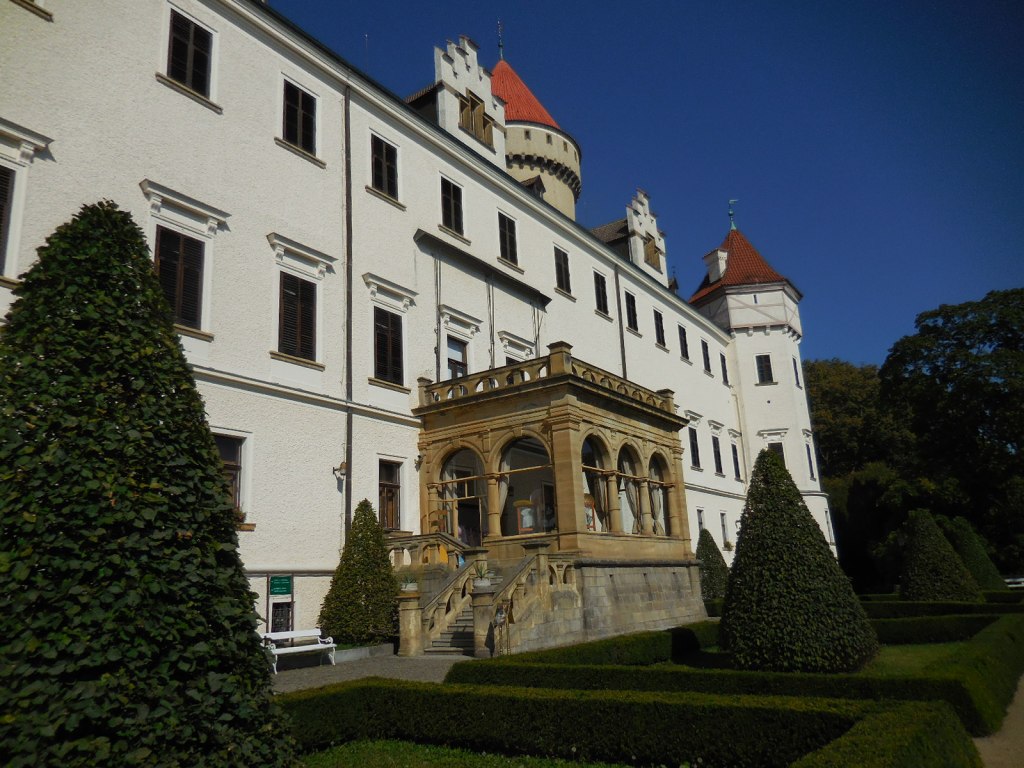
I had been to Konopiště Chateau at least seven times. The tours were always packed with 30 tourists or more, which could be a bit disconcerting. About 40 kilometers from Prague, Konopiště is a popular sight for day trips from the capital city and is usually swamped with tourists.
This time, though, there were only about five of us on each tour. It was during the coronavirus pandemic, at the beginning of September of 2020, when the situation was just starting to get worse. (It would be our last day trip during 2020 because of the steady increase in coronavirus cases.) The courtyard was almost empty. A few tourists waited on benches and fiddled with their cameras. No tour buses traveled there at that time because of the pandemic. We wore our masks and were able to social distance from each other on the tours.

By my 2020 visit, I knew the history of Konopiště well. The chateau of four wings and three storeys came into being as a Gothic fort with stellar defense features in the 1280s. The Šternberks took control of the castle in 1327, and it remained their property for more than 275 years. Konopiště survived the 15th century Hussite Wars without a scratch, a much different fate than so many other Czech castles that were plundered and even destroyed. Konopiště got a Gothic-Renaissance makeover during the late 15th century thanks to George of Šternberk. It became a Renaissance chateau when the Lords of Hodějov owned it in the 17th century. The Lords of Hodějov rebelled against the Habsburg monarchy in 1620, and the chateau was confiscated from them, placed in the possession of military leader Albrecht von Wallenstein.

While Konopiště had experienced good fortune during the Hussite Wars, the same could not be said about their fate during the Thirty Years’ War. The Swedes plundered it in 1648, and throughout the war, the chateau suffered serious damage. After Adam Michna acquired the chateau, the serfs rebelled against his repressive measures and conquered Konopiště in 1657. The Czech kingdom’s highest burgrave, Jan Josef of Vrtba, purchased Konopiště when it was in a decrepit state and transformed it into a luxurious Baroque chateau. Later, the chateau’s interior would also feature some Rococo elements.
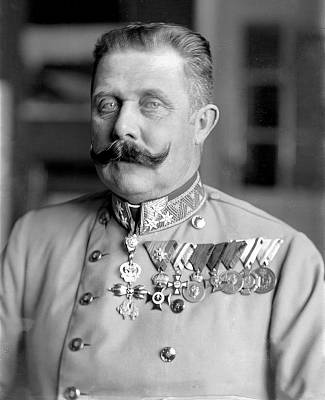
Archduke Franz Ferdinand d’Este – Photo from Dotyk
During 1887 Franz Ferdinand d’Este purchased the chateau. He was the oldest nephew of Austrian Emperor Franz Josef and later would become the heir to the Habsburg throne. He made a multitude of changes to the chateau, reconstructing it as a Renaissance residence with North Italian features. One part of the chateau was remodeled to look medieval. Architect Joseph Mocker carried out the renovations between 1889 and 1894. The archduke founded the 225-hectare English style park with the exquisite rose glarden. He established what is today the third largest European collection of armory and medieval weapons. Perhaps what stood out the most was his impressive collection of hunting trophies that are seen in the hallway at the beginning and throughout the tour.
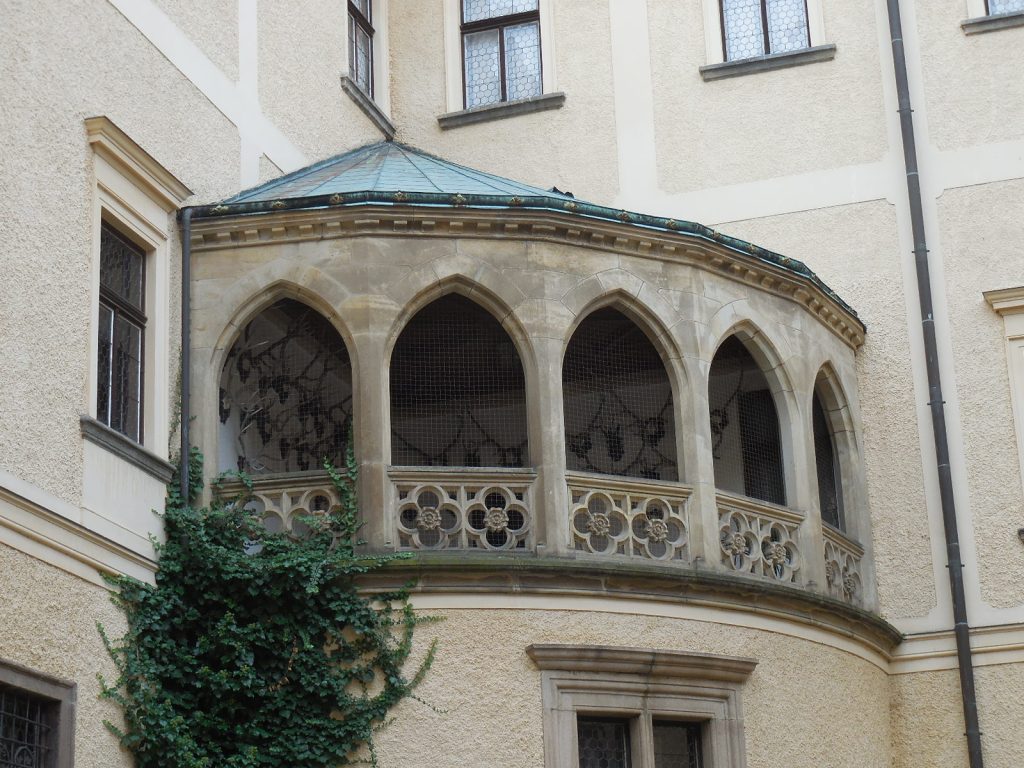
He also installed modern technical features, such as a hydraulic elevator, central heating and electricity. His vast collection of items dedicated to Saint George are located in the former orangery. After his assassination in Sarajevo during 1918, the First World War took place, and the chateau was plundered. During World War II the chateau served as a headquarters for the Nazis. It was nationalized in 1945, after World War II.
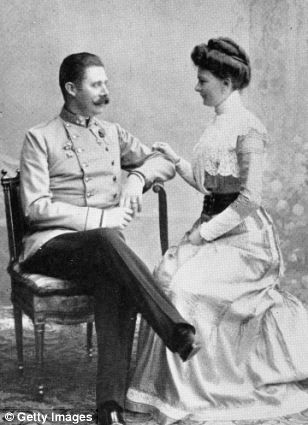
Franz Ferdinand d’Este and his wife Sophie Chotek – Photo from Pinterest.
To know the history of Konopiště, it is necessary to know more about Franz Ferdinand d’Este. The oldest son of the brother of Emperor Franz Joseph I, he became heir to the Habsburg throne after his cousin Crown Prince Rudolf killed himself and his father died. The Crown Prince, the only son of Emperor Franz Joseph I, committed suicide along with his mistress, Mary Freiin von Vetsera, at Mayerling hunting lodge in 1889. Franz Ferdinand achieved much success in the military. However, he often disagreed with Emperor Franz Josef and was by no means a favorite of the emperor.

Sophie Chotek – Photo from Alchetron.
He was smitten by Sophie Chotek, a lady-in-waiting to Archduchess Isabella. The two were secret lovers for two years because Sophie was not descended from the Habsburgs or any other European ruling dynasty, something that caused much tension between Franz Ferdinand and Emperor Franz Josef. The emperor did eventually allow the couple to wed, but he set rigid conditions. None of their children could be heirs to the throne. Also, Sophie was forbidden to sit in the royal carriage or royal box.

They were married at Baroque Zákupy Chateau in northern Bohemia, a place I had visited a few years earlier. I recalled the many portraits and pictures of members of the monarchy at Zákupy. Franz Joseph had used the place as a summer residence for some time in the second half of the 19th century. I remembered what I liked best about Zákupy’s interior. I loved the delicate, decorative painting of Josef Navrátil on the upper walls and ceilings of many rooms. A fantasy-inspired painting of the four continents had also held my attention. The 17th century Baroque chapel was amazing with ceiling frescoes portraying scenes from the lives of the Virgin Mary and Jesus.
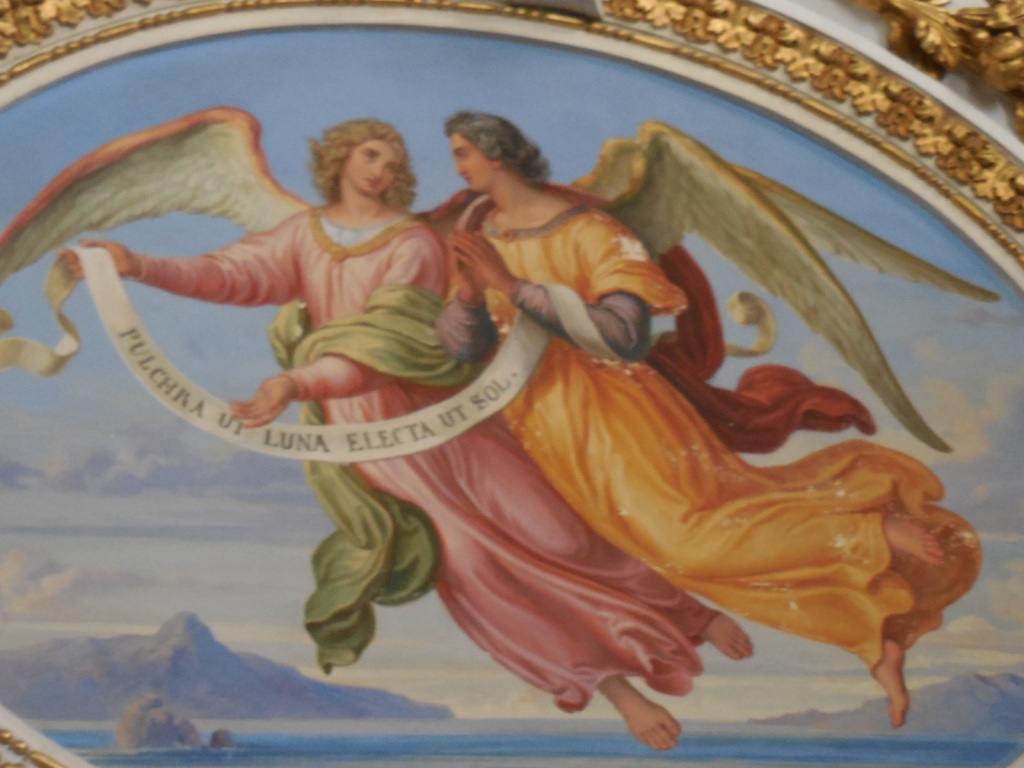

Franz Ferdinand and Sophie had three children and were married for 14 years. The couple was assassinated by Gavrilo Princip, a member of the Black Hand terrorist group, on June 28, 1914 in Sarajevo. Franz Ferdinand and his wife had travelled to Sarajevo because Franz Ferdinand wanted to oversee military maneuvers. Less than two months after their tragic deaths, World War I broke out.

Soon it was time for the tour. One characteristic that has always enthralled me is that the chateau has 96 percent of its original furnishings. So many original furnishings of castles and chateaus had been destroyed or lost. Photographs of Konopiště’s interiors from Franz Ferdinand’s ownership of the chateau made it possible to see the spaces as they really had looked during that time period.

As we admired the luxurious spaces on the first tour, I recalled that Franz Ferdinand and Konopiště were mentioned in Jaroslav Hašek’s The Good Soldier Švejk and His Fortunes in the World War, an anti-militaristic, satirical novel sprinkled with anecdotes in which Švejk, a gung-ho soldier serving in the Austro-Hungarian Empire, appears to be an idiot. It is not clear if he is pretending to be an idiot. Originally published from 1921 to 1923, the book was never finished as Hašek succumbed to a heart attack while writing it. The Good Soldier Švejk, as it is often called, holds the distinction of being the most translated book in Czech literature.

Photo from booktook
The first tour showed off some 5,000 numbered hunting trophies, many of exotic animals, as Franz Ferdinand had travelled all over the world on hunting expeditions. Many trophies consisted of exotic animals. I saw bears, antelopes and wild cats, for instance. The archduke had also killed 12 Indian tigers. There was also a collection of 3,200 pairs of deer teeth. But Konopiště is much more than its seemingly ever-present hunting souvenirs.

One of the most impressive spaces is the Rose Room, which has an exquisite pink ceiling and shows off 19th century Rococo furniture. Its Czech crystal chandelier is another delight. I was especially drawn to an Empire style table adorned with gemstones. I loved the three Italian marble cabinets that sported drawers decorated with leaves, fruit, animals and birds. I noticed the delicate ruddy cheeks of Marie Antoinette in one portrait. The Grand Dining Room stood out for its Baroque ceiling that portrays the four seasons and a Czech crystal chandelier weighing 170 kilograms. The 15th century paintings in William II’s Bedroom caught my undivided attention. An exquisite Spanish tapestry of a forest with people on horseback hung in one room. A beautiful yellow, blue and white tiled stove stood out in the Guest Bedroom. A Venetian mirror showed off a picture of Saint George. Many artifacts on the tours were decorated with likenesses of Saint George.

The second tour of the chateau included rooms specifically meant for Crown Prince Rudolf, though he died before he could visit his cousin. Franz Ferdinand had been very close to the Crown Prince and had taken his death very hard. On this tour we learned many interesting facts about Franz Ferdinand’s life. The guide told us that Franz Ferdinand’s brother encouraged him to keep Sophie as a mistress instead of marrying her. Franz Ferdinand never spoke to his brother again.
I marveled at the 16th century Renaissance vaulting throughout the rooms. These spaces make up the oldest part of the castle. My favorite room was the chapel, one of my favorite chapels in the country. It was a place where I could have imagined having my wedding if I had found someone to marry. I was awed by the 19th century blue vaulted ceiling speckled with gold stars, symbolizing the sky. The 15th and 16th century sculptures also amazed. The main altar was Gothic, featuring the Virgin Mary and Jesus. Saint Hubert and Saint George (of course!) also made appearances. Instead of an organ, the chapel was equipped with a harmonium, and it still worked. I loved the bright colors of the chapel – they had such a distinctive vibrancy that gave off positive energy. Also, the small chapel had an intimate feel.

Even though I was not a big fan of weapons, the armory was very impressive. I saw 15th century weapons from the Hussite wars, executioners’ swords and complete armor for a horse and knight hailing from 1560. Renaissance armor for a musician from 1600 was exquisitely decorated with pictures of instruments. A rifle made of ebony hailed from the beginning of the 16th century. Cannons on display had been used during the Thirty Years’ War. Some shields were decorated with mythological themes. One showed a fighting Hercules. I also saw rifles and pistols made in the 16th and 17th century.

There was even more to admire on that tour. An electric elevator with plush seats looked like a small, luxurious train compartment. Franz Ferdinand had equipped the chateau with the most modern technology of the time period. I liked the ashtray made of part of an elephant’s foot. In the Smoking Salon, a 16th century tapestry portraying King of Macedon Alexander the Great caught my attention. Also, the 17th century monumental fireplace adorned with figures of lions and coats-of-arms was carved from rare Italian Carrara marble. Toward the end of the tour, we saw a stuffed bear that had lived in the chateau’s moat until 2007. Now another bear, named Jiří (George), resided there, though I hadn’t seen him when I had looked over the moat during this visit.
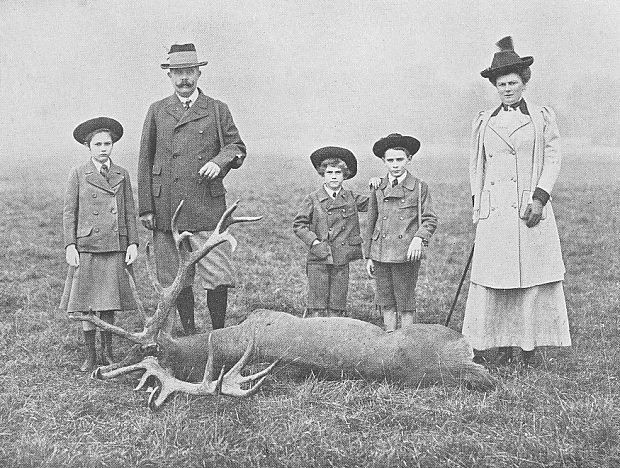
Franz Ferdinand and his family hunting, Image from treking.cz
The third tour, the one featuring Franz Ferdinand d’Este’s private apartments, lasted 90 minutes and was as enthralling as I had remembered it. We started off in the 70-meter-long hallway where over 800 of Franz Ferdinand’s hunting trophies were displayed. I especially noticed the razor-sharp teeth of an open-mouthed tiger. In another space I was drawn to a Nuremberg chandelier made with deer antlers and decorated with mythological figures.

Franz Ferdinand, Sophie and family, Image from stoplusjednicka.cz
My favorite part of the tour came next. We walked down a hallway lined with portraits of historical figures, such as Dante Alighieri, Titian and Christopher Columbus. Empress Maria Theresa’s likeness stood out as well. In another space, I noticed the delicate embroidery on Franz Ferdinand’s uniforms, such as his attire as a Russian general. The chest that traveled to Sarajevo with Franz Ferdinand and his wife made an appearance, too. The gigantic tooth of a whale was intimidating. Portraits of Emperor Franz Josef I dotted the apartments. Each time I saw one, I recalled the rigid conditions that Emperor Franz Josef had put in place while allowing the two lovebirds to marry. I also noticed the fine woodworking craftsmanship on the headboard of a bed.
Eventually, we came to a room where there were 1,307 hunting trophies. I remembered the space from one of my favorite films, featuring the fictional Czech legendary character Jára Cimrman, who was the focus of a small, intimate theatre in Prague’s Žižkov district. I noticed a lighter in the shape of a dog on a desk. In the Dining Room the tiled stove was enchanting. I loved seeing various styles of tiled stoves in chateaus.

I took note of a painting of Saint George killing the dragon, a theme featured throughout the chateau in 3,900 objects. Franz Ferdinand had wanted to impress King George with his collection and persuade him to visit Konopiště, but his dream was never realized because Franz Ferdinand d’Este was assassinated in Sarajevo.
A miniature jewel case sporting the intarsia method caught my eye. In the Pink Salon I was captivated by one of many portraits. It showed a young Sophie Chotek, Franz Ferdinand d’ Este’s wife, with a wreath of flowers in her hair. I recalled that neither she nor her children could have the Habsburg title because she was not descended from a European ruling dynasty. I mused that their children could never become heirs to the throne as I stared at a huge portrait of the three offspring. They looked serious, pondering. In a bedroom with 20th century furniture there was a Madonna painting. I liked the tan-and-black color combination for the bedspread. I also liked the pale-yellow bedspreads in the room for Arnošt and Maximilián, the two sons. The model boats in the room were very detailed. A huge portrait showed the boys in the chateau park. I imagined them frolicking through the impressive park, carefree and full of joy. A photo showed them in sailors’ uniforms, standing with their father. In another portrait the two boys were dressed in girls’ clothes because this was the normal attire for young boys during that era. I tried to imagine the boys playing Indians, reading adventure books by Karel May or playing puppet theatre with a Saint George and the dragon theme. I also saw portraits of dogs, textbooks and collections of fairy tales. The guide showed us a magazine the children produced about music, dogs and birds, for instance.

Countess Sophie Chotek, Image from flikr
I also was shown the room where the children’s French and music teacher had slept. Franz Ferdinand’s children had kept in touch with her even after becoming adults. In the daughter’s room I especially liked the Venetian mirror and took notice of the delightful floral bedspread and floral upholstery of the furniture. In another space the Delft porcelain caught my eye. I thought of the Delft porcelain at Zákupy Chateau, where Franz Ferdinand and Sophie had wed. I had admired Delft porcelain in so many chateaus and palaces. A magnificent tiled stove in green, blue and yellow stood out, too.
We were in the chapel briefly. The biblical scenes shown in the stained-glass windows captivated me as did the many sculptures. The blue ceiling decorated with gold stars was my favorite feature of the chapel. This was definitely one of my favorite chateau chapels of all time, I mused. I could have spent an hour just perusing the chapel because it showed off so much precious decoration.

Archduke Franz Ferdinand d’Este and Countess Sophie Chotek in Sarajevo, Image from http://www.payne.cz
In another room there were black-and-white photos of the family’s travels to Japan, China and India, for example. I perused shots taken in Nepal and Calcutta as well as one of an elephant in Ceylon. While some pictures showcased the landscape, others focused on people. The hydraulic elevator with comfortable, upholstered seating had traveled a half-meter each second.
Finally, we came to a display case holding Franz Ferdinand’s and Sophie’s death masks and one of the bullets from Gavrilo Princip’s pistol. Such a small object had produced a fatal wound. Blood stained an otherwise dainty handkerchief. The delicate white dress and white hat Sophie had been wearing when she was shot were in full view as well. The white color of her attire somehow made her assassination seem all the more tragic.
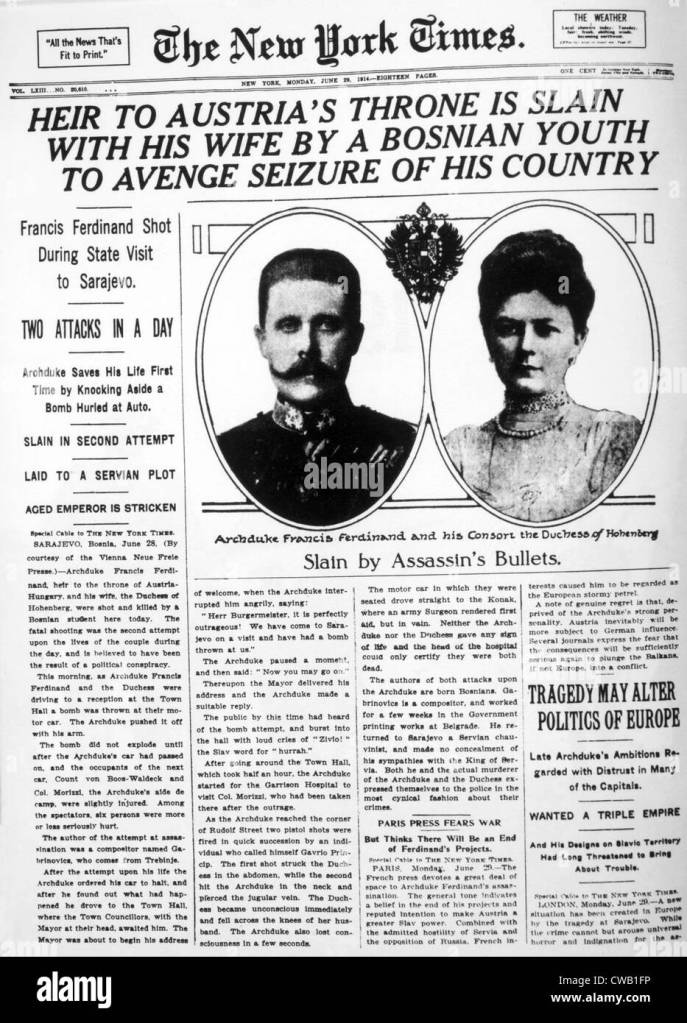
The New York Times’ article about the assassination in Sarejevo, Image from http://www.alamy.com
I also visited the Shooting Hall in the former stables, which hailed from Franz Ferdinand’s time at the chateau. I was impressed with the astounding detail of the painted moving targets of various people and animals. The museum of 808 objects depicting Saint George killing the dragon in the former orangery was another delight. Franz Ferdinand had collected these paintings, statues, ceramics, glass and altarpieces with the hopes that one day Britain’s King George would visit the chateau. That dream was cut short by Franz Ferdinand’s death.

Then there was the vast park, which we only had a little time to visit. The rose garden had always been my favorite part of the park along with its numerous Italian sculptures. I also had an affinity for the greenhouse and its intriguing plants. I had been at the park during the spring and summer previous years, so I had seen it in full bloom.
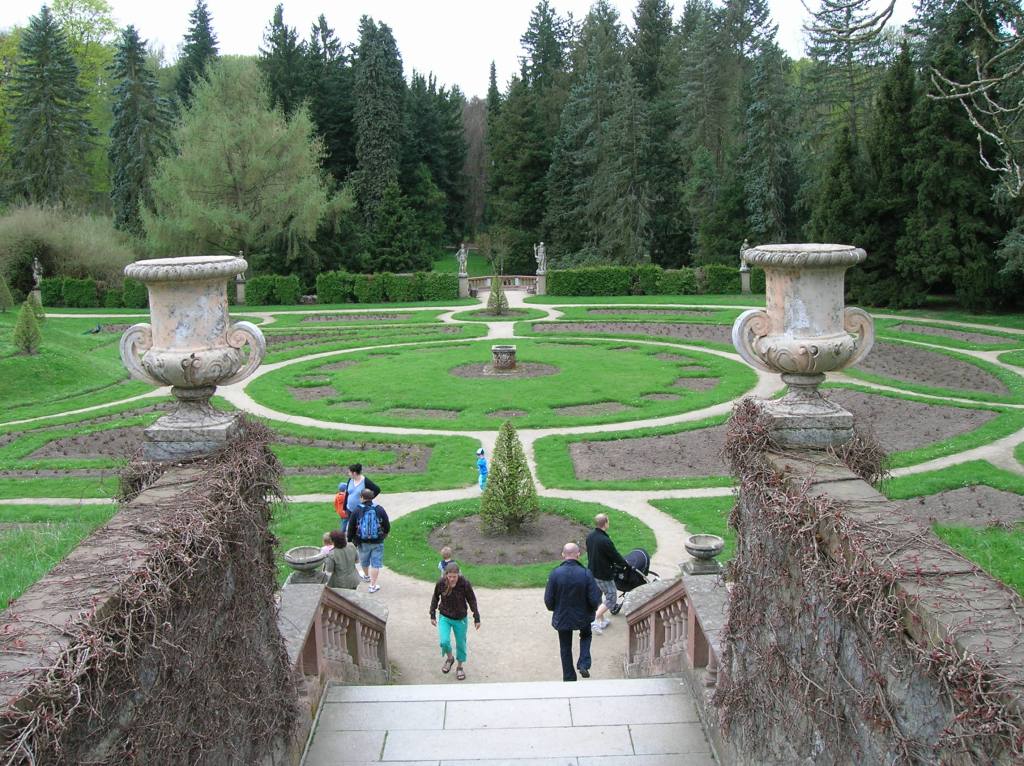
Then it was time to eat. We were the only customers in the cozy chateau restaurant. I had chicken and couldn’t resist a large sundae for dessert. I loved treating myself to ice cream on my day trips. It made them even more special. I would remember this sundae more than others because it would be my last at a chateau for the season. I can still savor the vanilla and chocolate. . . .
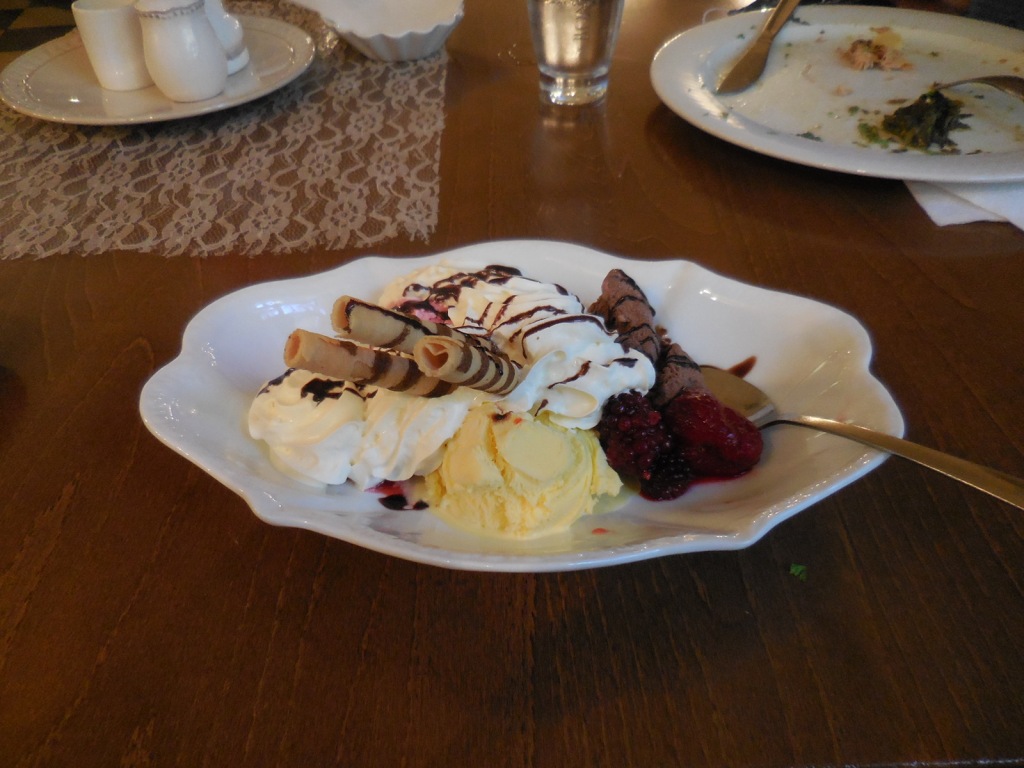
Tracy A. Burns is a writer, proofreader and editor in Prague.